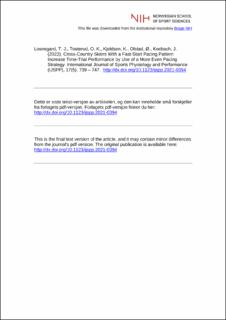| dc.description.abstract | Purpose: To investigate whether skiers with a fast-start pacing pattern increase time-trial performance by use of a more even pacing strategy. Methods: Thirty-four skiers (∼17 y, 16 male) performed an individual 7.5 (3 × 2.5) km free-technique race on snow with a self-selected pacing strategy (day 1). Based on the starting pace the first ∼2 minutes (lap-1 first 600-m segment pace·7.5 km pace−1), subjects were ranked into 2 groups: an intervention group with the fastest start pace (INT, n = 17) and a control group with a more conservative pace (CON, n = 17). On day 2, INT were instructed to reduce their start pace based on their average laps-1-to-3 segment pace from day 1, while CON were instructed to maintain their day 1 strategy. Results: INT increased their time-trial performance more than CON from day 1 to day 2 (effect size; ES = 0.87, P < .05). From day 1 to day 2, INT slowed their start pace (mean ± 95% confidence interval; 7.7% ± 2.0%, ES = 2.00), with lowered heart rate (HR) (83% ± 2% to 81% ± 2% of HRmax) and 1 to 10 ratings of perceived exertion (5 ± 1 to 4 ± 1), but finished with a faster overall 7.5-km time (−1.9% ± 0.9%, ES = 0.99) (all P < .05). For CON, no change was found for starting pace (−0.7% ± 2.0%, P = .47), overall 7.5-km time (−0.2% ± 1.4%, ES = 0.02, P = .81), ratings of perceived exertion, or HR between days. No differences were found for end-ratings of perceived exertion (9 ± 1) or average HR between day 1 and 2 for either group. Conclusion: Skiers with a pronounced fast-start pattern benefit by using a more even pacing strategy to optimize time-trial distance skiing performance. | en_US |
